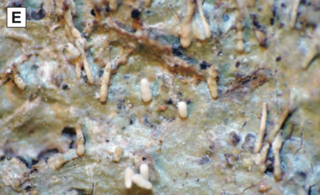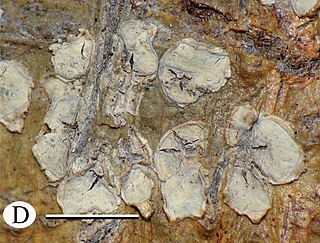
The Graphidaceae are a family of lichen-forming fungi in the order Graphidales. The family contains nearly a hundred genera and more than 2000 species. Although the family has a cosmopolitan distribution, most Graphidaceae species occur in tropical regions, and typically grow on bark.

Fissurina is a genus of lichenized fungi in the family Graphidaceae. It has about 160 species, most of which are found in tropical regions.

Diorygma is a genus of lichen-forming fungi in the family Graphidaceae. The genus was circumscribed by Franz Gerhard Eschweiler in 1824. Species of the genus are widely distributed in tropical and subtropical regions of the world.

Myriotrema is a genus of lichen-forming fungi in the family Graphidaceae.
Leucodecton is a genus of lichen-forming fungi in the family Graphidaceae. The genus was circumscribed in 1860 by Swiss lichenologist Abramo Bartolommeo Massalongo, with Leucodecton compunctum assigned as the type species.
Chapsa is a genus of lichens in the family Graphidaceae. The genus was circumscribed by Italian lichenologist Abramo Bartolommeo Massalongo in 1860.

Acanthotrema is a genus of lichens in the family Graphidaceae. The genus was circumscribed by German lichenologist Andreas Frisch in 2006, with Acanthotrema brasilianum assigned as the type species. Acanthotrema species are commonly found in rainforests ranging from lowland to montane environments.

Thelotrema is a genus of lichen-forming fungi in the family Graphidaceae, the family to which all taxa in the former Thelotremataceae now belong.

Astrochapsa is a genus of lichen-forming fungi in the subfamily Graphidoideae of the family Graphidaceae. It has 28 species. The genus was circumscribed by Sittiporn Parnmen, Robert Lücking, and H. Thorsten Lumbsch in 2012, with Astrochapsa astroidea assigned as the type species. It was segregated from the genus Chapsa, from which it differs in having a more frequently densely corticate thallus, an apothecial margin that is mostly recurved, and the almost exclusively subdistoseptate, non-amyloid ascospores.
Wirthiotrema is a genus of lichen-forming fungi in the family Graphidaceae. The genus was circumscribed in 2010 by Eimy Rivas Plata, Klaus Kalb, Andreas Frisch, and H. Thorsten Lumbsch, with Wirthiotrema glaucopallens assigned as the type species. Wirthiotrema contains species that were formerly considered part of the Thelotrema glaucopallens species group. The genus name honours lichenologist Volkmar Wirth, "for his numerous outstanding contributions to lichenology".
Halegrapha is a genus of lichen-forming fungi in the family Graphidaceae. It has nine species. The genus was circumscribed in 2011 by Eimy Rivas Plata and Robert Lücking, with Halegrapha chimaera assigned as the type species. The generic name honors American lichenologist Mason Hale.
Rhabdodiscus is a genus of script lichens in the family Graphidaceae. It has 36 species.
Schizotrema is a genus of lichen-forming fungi in the family Graphidaceae. The genus was circumscribed in 2009 by Armin Mangold and H. Thorsten Lumbsch.
Pseudochapsa is a genus of lichen-forming fungi in the family Graphidaceae. It has 19 species. It was circumscribed in 2012 by Sittiporn Parnmen, Robert Lücking, and Helge Thorsten Lumbsch, with Pseudochapsa dilatata as the type species. Pseudochapsa differs from Chapsa it that its excipulum is typically brown. Additionally, its ascospores are mostly discoseptate and amyloid. The generic name combines the Greek pseudo ("false") with the genus name Chapsa.
Cruentotrema is a genus of corticolous (bark-dwelling) lichens in the family Graphidaceae. It has seven species.
Graphidales is an order of lichen-forming fungi in the class Lecanoromycetes. It contains 6 families, about 81 genera and about 2,228 species. Family Graphidaceae are the largest crustose family within Graphidales order comprising more than 2000 species, which are widely distributed in tropical and subtropical regions of the world.
Gintarasia is a genus of lichen-forming fungi in the family Graphidaceae. It has seven species, all of which are found in Australia. Gintarasia species are corticolous (bark-dwelling), crustose lichens with a thelotremoid form.
Acanthotrema frischii is a species of corticolous (bark-dwelling) lichen in the family Graphidaceae. Found in the East Province of Cameroon, A. frischii has a smooth, olive-green thallus, and its broadly oval, glass-like ascospores. Although initially believed to represent Acanthotrema brasilianum, a Neotropical species, it was identified as a distinct species due to differences in ascospore structure.
Compositrema is a genus of lichen-forming fungi in the family Graphidaceae. It has four species. The genus was circumscribed in 2012 by lichenologists Eimy Rivas Plata, Robert Lücking, and Helge Thorsten Lumbsch, with C. cerebriforme assigned as the type species. The genus is distinguished by its unique, composite pseudostromatic ascomata, which sets it apart from the otherwise similar genus Stegobolus.






